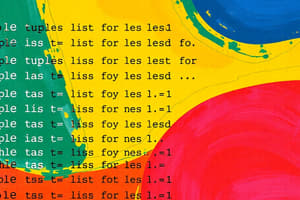Podcast
Questions and Answers
What distinguishes a tuple from a list in Python?
What distinguishes a tuple from a list in Python?
- Tuples are ordered and immutable, while lists are ordered and mutable. (correct)
- Lists cannot contain duplicate elements while tuples can.
- Lists can contain elements of different types while tuples cannot.
- Tuples are mutable and lists are immutable.
Which statement about dictionaries in Python is true?
Which statement about dictionaries in Python is true?
- Dictionaries are ordered collections of items.
- Values in a dictionary must be unique.
- Keys in a dictionary can be mutable objects.
- Dictionaries store data in key-value pairs. (correct)
What is a major characteristic of a set in Python?
What is a major characteristic of a set in Python?
- Sets maintain the order of elements.
- Sets allow duplicate elements.
- Sets are mutable but cannot be modified after creation.
- Sets are collections of unique items. (correct)
Which of the following correctly describes inheritance in object-oriented programming?
Which of the following correctly describes inheritance in object-oriented programming?
Which feature of object-oriented programming allows different classes to implement the same method call in various ways?
Which feature of object-oriented programming allows different classes to implement the same method call in various ways?
What role do attributes play in a Python class?
What role do attributes play in a Python class?
In Python, what is meant by code being 'dynamically typed'?
In Python, what is meant by code being 'dynamically typed'?
Which of the following data structures would you use to store an unordered collection of unique items in Python?
Which of the following data structures would you use to store an unordered collection of unique items in Python?
Flashcards
Python
Python
A high-level, general-purpose programming language known for its readability and extensive libraries.
Interpreted Language
Interpreted Language
Python code is executed line by line, rather than compiled into machine code beforehand.
Dynamically Typed
Dynamically Typed
Python checks data types during runtime, not before the code runs.
Data Structures
Data Structures
Signup and view all the flashcards
Lists
Lists
Signup and view all the flashcards
Tuples
Tuples
Signup and view all the flashcards
Dictionaries
Dictionaries
Signup and view all the flashcards
Sets
Sets
Signup and view all the flashcards
OOP
OOP
Signup and view all the flashcards
Classes
Classes
Signup and view all the flashcards
Objects
Objects
Signup and view all the flashcards
Attributes
Attributes
Signup and view all the flashcards
Methods
Methods
Signup and view all the flashcards
Encapsulation
Encapsulation
Signup and view all the flashcards
Inheritance
Inheritance
Signup and view all the flashcards
Polymorphism
Polymorphism
Signup and view all the flashcards
Study Notes
Python
- Python is a high-level, general-purpose programming language.
- Interpreted language: code is executed line by line.
- Dynamically typed: data types are checked at runtime, not compile time.
- Readable syntax: emphasizes code clarity.
- Extensive libraries and frameworks for various applications.
- Widely used in web development, data science, machine learning, automation, and more.
- Excellent for beginners due to its ease of use and readability.
Data Structures
- Data structures organize and store data efficiently.
- Common data structures in Python: lists, tuples, dictionaries, sets.
- Lists: ordered, mutable sequences of items.
- Can contain elements of different types.
- Accessed by index (starting at 0).
- Methods for adding, removing, and modifying elements.
- Tuples: ordered, immutable sequences of items.
- Similar to lists but cannot be changed after creation.
- Useful for representing fixed collections of data.
- Dictionaries: key-value pairs, unordered collection of items.
- Keys must be immutable (e.g., strings, numbers).
- Values can be any data type.
- Accessed by keys.
- Sets: unordered collections of unique items.
- Useful for membership testing and eliminating duplicates.
- Support mathematical operations like union, intersection, etc.
Object-Oriented Programming (OOP) in Python
- OOP is a programming paradigm that organizes software design around 'objects'.
- Objects encapsulate data (attributes) and methods (functions) that operate on that data.
- Key OOP concepts in Python:
- Classes: blueprints for creating objects.
- Objects (instances): specific occurrences of a class.
- Attributes: data associated with an object.
- Methods: functions that operate on an object's attributes.
- Encapsulation: bundling data and methods that operate on the data within a class.
- Helps in controlling access to data.
- Inheritance: creating new classes (child classes) from existing ones (parent classes).
- Child classes inherit attributes and methods from the parent.
- Extends and builds upon existing functionalities.
- Polymorphism: the ability of objects of different classes to respond to the same method call in their own way.
- Example demonstrating a simple class definition
class Dog:
def __init__(self, name, breed):
self.name = name
self.breed = breed
def bark(self):
print("Woof!")
my_dog = Dog("Buddy", "Golden Retriever")
print(my_dog.name)
my_dog.bark()
- Python supports multiple inheritance, where a class can inherit from multiple parent classes.
- Python uses special methods (e.g.,
__init__,__str__) to customize object behavior. - Abstraction: creating simplified representations of complex objects, simplifying code and enhancing maintainability.
Studying That Suits You
Use AI to generate personalized quizzes and flashcards to suit your learning preferences.




